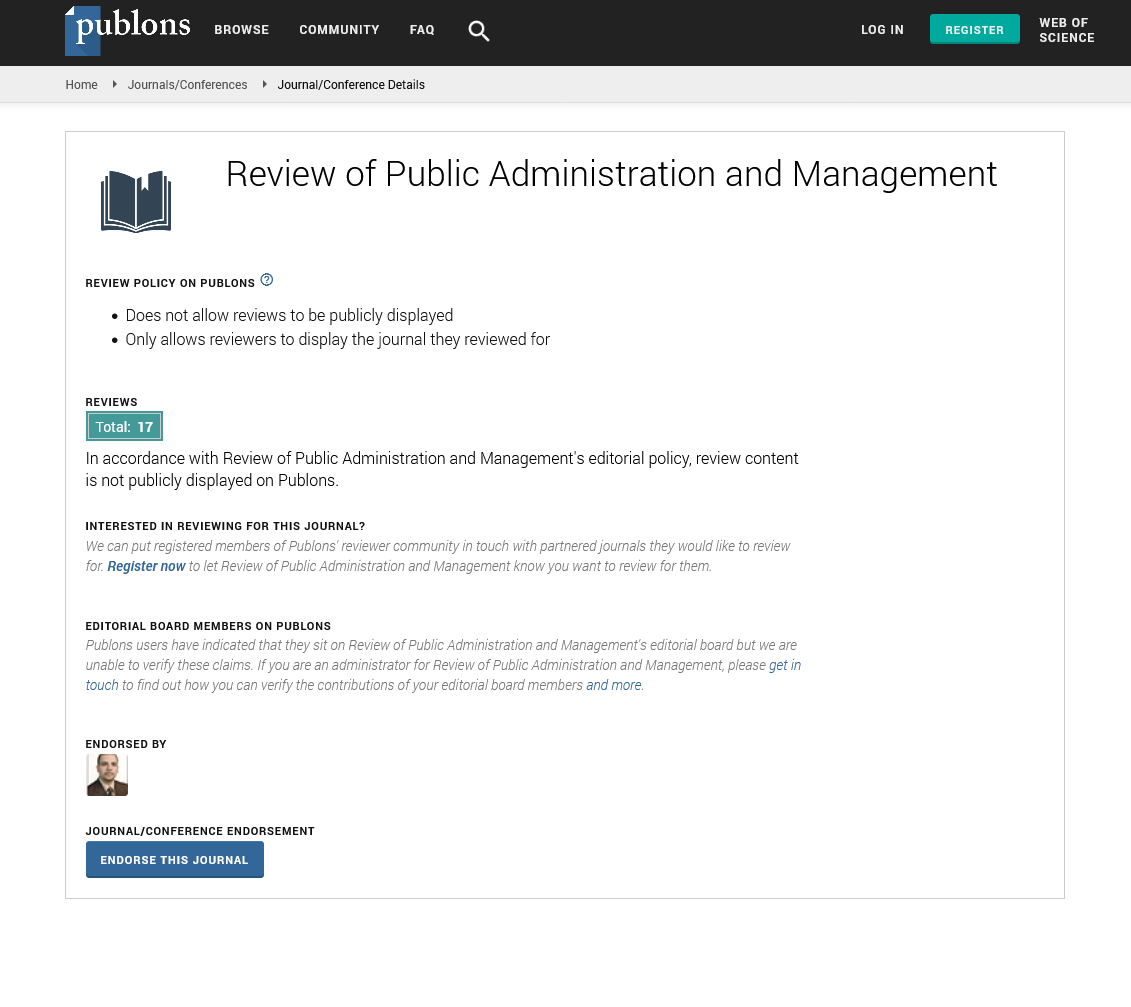Indexed In
- CiteFactor
- RefSeek
- Directory of Research Journal Indexing (DRJI)
- Hamdard University
- EBSCO A-Z
- Scholarsteer
- Publons
- Euro Pub
- Google Scholar
Useful Links
Share This Page
Journal Flyer

Open Access Journals
- Agri and Aquaculture
- Biochemistry
- Bioinformatics & Systems Biology
- Business & Management
- Chemistry
- Clinical Sciences
- Engineering
- Food & Nutrition
- General Science
- Genetics & Molecular Biology
- Immunology & Microbiology
- Medical Sciences
- Neuroscience & Psychology
- Nursing & Health Care
- Pharmaceutical Sciences
Perspective - (2025) Volume 13, Issue 2
Public Sector Innovation and Service Improvement
Hiroshi Takeda*Received: 02-Jun-2025, Manuscript No. RPAM-25-29757; Editor assigned: 04-Jun-2025, Pre QC No. RPAM-25-29757; Reviewed: 17-Jun-2025, QC No. RPAM-25-29757; Revised: 21-Jun-2025, Manuscript No. RPAM-25-29757; Published: 28-Jun-2025, DOI: 10.35248/2315-7844.25.13.493
Description
Public administration has always been tasked with ensuring that citizens receive essential services efficiently and equitably. Yet in recent decades, the expectations placed on public institutions have grown substantially. Citizens demand not only reliable services but also greater convenience, personalization and transparency. At the same time, resource constraints, demographic shifts and rapid technological advances create pressures that challenge traditional methods of service delivery. In this environment, innovation in the public sector becomes a necessity rather than a luxury. Innovation in public administration does not imply merely adopting new technologies it encompasses fresh approaches to organizational structures, decision-making processes, citizen engagement and inter-agency collaboration. While private companies often innovate to secure competitive advantages, the public sector seeks innovation to enhance service quality, reduce costs and strengthen trust in institutions. Unlike the private sector, however, public sector innovation must also account for inclusiveness, accountability and ethical considerations.
A central driver of public sector innovation has been digital transformation. Advances in information and communication technology have enabled governments to deliver services online, making them more accessible and efficient. Japan provides an instructive example. Over the last two decades, administrative offices in Tokyo and other cities have increasingly shifted services such as tax filing, resident registration and license renewals to digital platforms. Citizens can complete procedures from their homes, reducing waiting times and bureaucratic burdens. This shift not only improves convenience but also frees administrative staff to focus on more complex tasks. Another significant trend is the use of data analytics in policymaking. Public administrations generate and manage vast amounts of data, ranging from census information to environmental monitoring. When analyzed effectively, this data can reveal patterns that improve decision-making and resource allocation. For instance, predictive analytics can help healthcare administrators anticipate disease outbreaks or guide transportation authorities in optimizing traffic management. In Tokyo, municipal data systems have been used to track urban heat islands, allowing targeted interventions such as tree planting and reflective pavement installation to mitigate rising temperatures. These data-driven approaches reflect how innovation can address pressing urban challenges while improving quality of life.
Public sector innovation also involves rethinking how services are delivered. Traditional bureaucratic models are often centralized, with agencies working in isolation. Innovative approaches emphasize collaboration across departments and with external factors such as private firms, civil society organizations and universities. Co-production, where citizens participate directly in designing and delivering services, represents another innovative trend. For example, some Japanese municipalities invite residents to propose community projects funded through participatory budgeting. This not only enhances the relevance of services but also deepens citizen trust by demonstrating that their voices matter in public decisionmaking. Despite the potential benefits, public sector innovation faces obstacles. Bureaucratic culture is often risk-averse, with officials reluctant to experiment due to fears of failure, political backlash, or legal liability. Moreover, innovation requires resources financial investment, technical expertise and time that may be scarce, especially in smaller municipalities. Leaders in public administration must therefore create environments that encourage experimentation while safeguarding accountability. Pilot projects, for example, allow administrators to test new approaches on a small scale before scaling them up.
International comparisons reveal diverse approaches to public sector innovation. In Estonia, the government has created a highly digitalized administrative system, with nearly all services available online. Citizens can vote, access health records and manage taxes digitally, supported by a secure digital identity system. In Brazil, innovation has focused on social inclusion, with digital platforms providing citizens in remote areas access to services such as education and healthcare. In Australia, service delivery has been enhanced through “one-stop” digital portals where citizens can access multiple services through a single login. These examples illustrate that innovation is context-dependent, shaped by political priorities, institutional capacity and societal needs. Innovation in public administration is also linked to organizational culture. Administrations that reward creativity, collaboration and problem-solving tend to generate more effective service improvements. Leadership plays a critical role in signaling that innovation is valued. Training programs that enhance digital literacy and project management skills among public employees are equally essential. Furthermore, partnerships with academic institutions and private technology firms provide additional expertise that governments may lack internally.
Citizen engagement is another crucial element of innovation. Public trust in institutions increases when citizens feel that their needs are heard and addressed. Innovative approaches such as crowdsourcing platforms allow citizens to contribute ideas for policy solutions. In France, for example, a national online platform enables citizens to propose environmental initiatives, some of which are then implemented at the municipal level. Such initiatives transform citizens from passive recipients of services into active partners in governance. Ethical considerations cannot be overlooked. While digital platforms and data analytics expand possibilities, they also raise concerns about privacy, security and equity. Administrations must establish safeguards to ensure that personal information is protected and that technological innovations do not exclude disadvantaged groups. Digital divides remain significant in many countries, with older populations or rural communities lacking access to reliable internet services. Addressing these divides requires complementary policies such as expanding broadband infrastructure and offering digital literacy training. Evaluating the success of public sector innovation is complex. Metrics such as cost savings and efficiency improvements are important, but they do not capture the full picture. Administrations must also assess citizen satisfaction, inclusiveness and long-term sustainability.
Citation: Takeda H (2025). Public Sector Innovation and Service Improvement. 13:493.
Copyright: © 2025 Takeda H. This is an open-access article distributed under the terms of the Creative Commons Attribution License, which permits unrestricted use, distribution and reproduction in any medium, provided the original author and source are credited.


